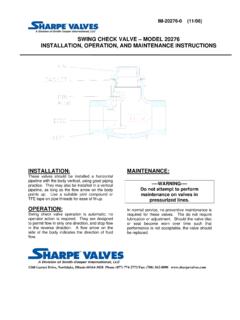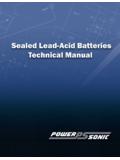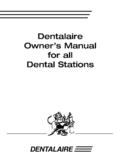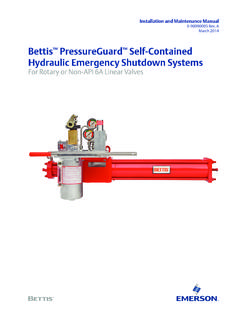Transcription of IOM Sonic Torque 4x4 8-15-07 - Sharpe® Valves
1 IM-4X4 8/15/2007 / REV. 0 Page 1 of 10 Installation, Operation, and maintenance manual Sonic Torque 4X4 4 Piston Pneumatic Actuator MODEL: X40, X50, X60, X75, X90, and X115 WARNING AND SAFETY INSTRUCTIONS: 1. Read this Installation, Operation & maintenance manual before using the actuator. 2. Sharpe Valves cannot anticipate all of the situations a user may encounter while installing and using the Sonic Torque - 4 Piston Pneumatic Actuator. The user must know and follow all applicable industry specifications on the safe installation and use of these actuators. Only qualified personnel or technicians who are trained for maintenance work and have read the instructions are to assemble and disassemble the actuator. Misapplication of the product may result in injuries or property damage. 3. Before operating an actuator which is connected to a valve in the pipeline, make sure you know the valve function.
2 4. Make sure the actuator is not connected to the air supply or electrical system before attempting to do any maintenance . 5. Before removing the actuator from the valve, always make sure the line has been depressurized and drained. Cycle the valve a few times to relieve any pressure that could be trapped in the body cavity. 6. Use only Sonic Torque components and spare parts supplied in the repair kits. 7. Do not use air pressure to remove actuator pistons when covers have been removed. 8. Do not leave any grip key or shaft connection attached to the actuator, or try to manually operate the actuator while it is still connected to the air supply. 9. The user must follow and observe any national or local safety law imposed for for his system. STORAGE The Sonic Torque 4 X 4- 4 Piston Actuator has been packaged to provide protection during shipment and storage. It is however, possible that the actuator can be damaged during transport.
3 Inspect actuator for shipping damage prior to storage. Keep the actuator in their original boxes and store indoor in a clean dry environment until ready for use. Keep plastic plugs in the air ports to prevent liquids or other materials from entering the actuator during storage. It is recommended to stroke them periodically to prevent setting of seals. OPERATING CONDITIONS: LUBRICATION The actuators are pre lubricated from the factory and under normal operating conditions do not require re-lubrication. In the event of actuator maintenance it is recommended to use the following lubricants: For NBR O-rings use EP1. The lubricant is suitable for use from -20 C to +80 C (-4 F to +176 F) with AIT/Flashpoint> (T-class +50K) IM-4X4 8/15/2007 / REV. 0 Page 2 of 10 For Viton O-rings use Molykote 111 or OKS 1110. The lubricant is suitable for use from -40 C to +140 C (-40 F to +284 F).
4 For EPDM O-rings use only Silicone grease SUPPLY PRESSURE The supply pressure for the 4 x 4 actuators are as follows: Double-acting: 2-8 barg (30-120 psig) Spring-return: 3-8 barg (40-120 psig) Spring-return actuators can also operate with air pressure of 2 barg (30 psig) by using the appropriate spring configuration as shown in the 4 x 4 catalogue. When sizing an actuator to available air supply, make sure you have adequate power in the actuator to allow the valve to complete its operation and leave enough power for safety margin. AIR SUPPLY Use clean dry air. Other inert gases may be used such as nitrogen and argon. Do not use water as supply media. Do not use oxidating, corrosive, flammable, explosive and unstable gases. Oxygen or hydrogen must not be used. The operating medium is to be filtered to 30 micron particle size or less.
5 Always consult with a representative of 4 x 4 for suitability and recommended practice. Piping connected to the actuator or accessories should be fitted according to recommended instrumentation piping practice. Prior to connection make sure all lines have no loops and are free of water, oil or other contaminants that may be trapped in the pipes. Pipes must be flushed with air to clean the passages. Where sealants are being used for threaded connections, care must be taken to avoid excess material been forced into the actuator ports. TEMPERATURE The standard temperature limits for the 4 x 4 actuators are -20 C (-4 F) to +80 C (+176 F) For temperatures below or above these figures special preparation and materials are required such as grease, O-rings, pinion bearing and pads. The 4 x 4 maximum working temperature is 130 C (266 F) when used with Viton O-rings and HT grease.
6 The minimum working temperature is -40 C (-40 F) when used with EPDM O-rings and LT grease. For temperatures below -40 C (-40 F) please consult with representative. When used in sub-zero temperatures it is essential to use an air dryer for the supply to avoid any moisture. Always consult with representative of 4 x 4 for suitability and recommended practice. PRINCIPLE OF OPERATION The 4 x 4 actuator is a pneumatic quarter-turn Rack & Pinion actuator. Air pressure applied to the piston surface area generates thrust which transforms linear motion to rotary motion of the pinion Fig 1. The 4 x 4 has four pistons centrally located around one pinion. This means that the actuator can generate twice the Torque of dual piston actuator, is lightweight, occupies minimum space and has minimal air consumption. Fig.
7 1 AIR CONNECTIONS The actuator air connections are marked A and B. Port B connects to a chain of holes to all the four pistons. The air passes into the Namur cover (or insert) and through holes which are connected to the neighboring pistons. Each piston receives the air flow from two directions which ensures a quick response. IM-4X4 8/15/2007 / REV. 0 Page 3 of 10 Looking from the top of the actuator. A port is on the left ; B port is on the right A B Fig. 2 Fig. 3 Double Acting (DA) Fig. 2: Pressure entering port A to open.
8 Center chamber pushes the pistons outward and rotates the pinion CCW (counter clockwise). Fig. 3: Pressure entering port B to close. The outer chamber pushes the pistons inward and Rotates the pinion CW (clockwise). Fig. 4 Fig. 5 Spring Return (SR) Fig. 4: Pressure entering port A to open. Pressure at enter chamber pushes the pistons outward and rotates the pinion CCW (counter clockwise). Fig. 5: Air released from center chamber. Spring pushes the pistons inward, Pinion rotates CW (clockwise). NAMUR Solenoid Mounting Air supply connection is done by mounting a solenoid (Fig. 6) directly onto the Namur cover which has a mounting pad conforming to the Namur standards.
9 (only Solenoids made to the NAMUR standard can be mounted in this way.) The 4 x 4 actuator can also be piped with solid or flexible tubing from remote solenoid Valves . Fig. 6 Fig. 8 ISO 5211 or DIN 3337 The actuator bottom flange is in accordance with ISO 5211 (or DIN 3337) International standard and incorporates a star shaped female drive for flexibility to fit various valve output shafts. The valve can be attached by bracket or mounted directly onto the actuator, using one of the various ISO hole patterns. Travel Adjustment The actuator comes factory adjusted to produce 90 rotation. The rotation is restricted by the IM-4X4 8/15/2007 / REV. 0 Page 4 of 10 stroke adjustment stop (14) and four adjustment screws (20) which provide fine tuning or a limiting stroke. The screws are threaded into the actuator body and are diametrically opposed to create simultaneous and equal forces on opposite sides of the stop to eliminate off-center forces.
10 The standard stop screws allow adjustment of +/-5 in the travel limits. Other Intermediate positions can be achieved with a longer set of stop screws which will enable travel from 0 to 20 and from 90 to 70 rotation. Fig. 9 Fig. 11 The standard stop screws allow adjustment of +/-5 in the travel limits. Other intermediate positions can be achieved with a longer set of stop screws which will enable travel from 90 to 70 rotation. Indicator All actuator are assembled with a highly visible indicator. The indicator have interchangeable snap-on flow direction arrows for identification of valve position. The arrows provide any type of pattern according to the valve ports. Fig. 12 TWO WAY THREE WAY L PORT Fig. 13 Use a screw driver or sharp object at the arrow head to push it out.

















